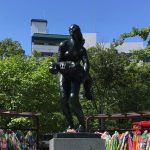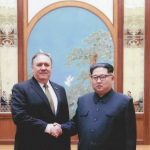What Do We Teach Our Students About Hiroshima and Nagasaki?
This article was originally published in Common Dreams.
By Emilie Clark
Last year, I joined a small group of activists in Staten Island, NY to march in remembrance of the nuclear bombings of Hiroshima and Nagasaki. This year I am representing Peace Action New York State as I march in Hiroshima itself, joining a world-wide network of activists calling for the end of nuclear weapons. Hearing the stories of Hibakushas (survivors of the atomic bombings) and seeing this vibrant movement for peace, I must ask myself, and I must ask all of you: if we don’t teach these stories in our schools, how are we preparing our students for the challenge of ensuring that history never repeats itself?
This annual Peace March extends from Tokyo to Hiroshima—over 500 miles for “through marchers”—spreading the message from city to city that nuclear threats should not be tolerated. At the end of my second day marching, gathered around a dinner table with marchers and community members aged 16 to 86, a retired English teacher put a book between us. As he began flipping through the pages, I was horrified. “Barefoot Gen,” is a famous book in Japan, written by a Hibakusha about his own experience living through the horrors of the U.S. bombing of his city. The illustrations depicted gruesome images of charred bodies floating in rivers, people violently vomiting blood due to radiation poisoning, and an entire city flattened.
My first instinct was to close the book, my stomach churned at the sight of the images, I couldn’t bear to continue eating my sashimi, and I caught myself thinking “why is this out at the dinner table?” Then I realized, my entire life I have been able to turn away from the destruction caused by my own country. Even in my activism, the temptation to shut the metaphorical book and continue about my life is ever present. The people of Hiroshima and Nagasaki did not have this option when the bombs fell, when they were crushed in their own homes, and when they died by the thousands from radiation poisoning for decades after. People living on islands throughout Micronesia are not able to turn away as they suffer and die from the highest rates of cancer in the world due to radiation from the atomic bomb testing in and around the island of Bikini.
I have worked in four different high schools in New York City, and have hardly heard these nuclear disasters mentioned. The few lines of a history book devoted to the stories of Hiroshima and Nagasaki get skimmed over and are quickly forgotten. We would be shocked to hear of a school not teaching its students about the attacks of September 11th, in which nearly 3,000 died, but we gloss over the stories of the more than 200,000 people who died as a result of the U.S. bombings in Hiroshima and Nagasaki. When we choose to not fully teach this portion of our country’s history, we fail more than just the victims and survivors in Japan, we fail our own students by depriving them of knowledge that might move them to accomplish what other generations have not—a world free from the threat of nuclear weapons.
So when a young person graduates high school in the U.S. at 18 and chooses not to vote in the upcoming congressional election, or casts a vote for a member of Congress who shares the sentiment of our current president that threatening nuclear war is a valid approach to foreign policy, do they know what they are voting for? How can we expect our citizens to make informed political choices when they are not equipped with a basic understanding of the apocalyptic mistakes of our country’s past?
Emilie K. Clark is the administrator at Peace Action New York State, part of the largest grassroots peace network in the United States. She is also a former social justice educator and a current graduate student at the Hunter College Silberman School of Social Work where she specializes in the study of trauma.





